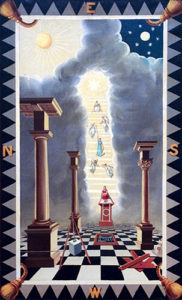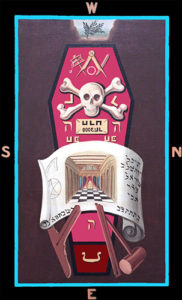The Blue Lodge, or Symbolic Lodge, is the fundamental body and mother of all Freemasonry. No other part of Masonry is accessible until one has received the three degrees of the Blue Lodge. This is the place where every man begins his journey into the Ancient Craft of Free and Accepted Masons.
The three degrees of the Blue Lodge:
As an Entered Apprentice Mason, the first step in your journey to the Sublime Degree of Master Mason has been taken. We are sure that you found your initiation an experience you will never forget. A degree in Masonry is not an isolated experience once had and then done with, but is an ever enduring privilege. You can sit in an Entered Apprentice Lodge to observe, to participate in, and to study its ceremonies.
Your possession of the degree is a life-long possession which you can continue to enjoy and to enter into as long as you live. As an Entered Apprentice Mason you therefore are a learner, or beginner, in Speculative Masonry. You have taken the first step in the mastery of our art. Certain things are expected of you.
First, you are expected to show a certain humility. As a learner, you must have guides and teachers, and you must be willing to have them lead you.
Second, you must learn the catechism of the Degree, so as to prove your proficiency in open Lodge. The purpose of learning the lecture is for you to master it so thoroughly that its lesson will remain with you for life.
Third, you must study and improve yourself in Masonry in all other possible ways. Your Lodge will not be content merely to receive your dues; it requires that you become a real and active member.
Fourth, you will learn the rules and regulations that govern an Entered Apprentice Mason.
As you stood in the northeast corner of the Lodge, you were taught a certain lesson concerning a cornerstone. From that lesson, you should know that you are a cornerstone of the Craft. It is our hope and prayer that you will prove to be a solid foundation as you proceed to the Fellow Craft Degree and then to the Master Mason Degree. Our great Fraternity depends on new members like you to conduct its work in the years to come.
The working tools of the Entered Apprentice are the Twenty-Four Inch Gauge, and the Common Gavel.
The Twenty-Four Inch Gauge was used by operative Masons to measure and lay out their work, but as speculative Masons we are taught to use it to divide the day into twenty four equal parts, where we find eight hours for duty to God and our fellow man, eight hours for our usual vocation, and eight hours for refreshment and sleep.
The Common Gavel was used by operative Masons to break off the rough edges of stones and fit them for the builder’s use. We use it for the purpose of divesting our minds of the vices and superfluities of life, to prepare yourself to be fit for the Great Architect’s use in constructing His spiritual building.
The Fellow Craft Degree places the candidate under an additional solemn obligation concerned primarily with his duties to his Brethren and the Craft.
 He is encouraged to become educated in the seven liberal arts and sciences:
He is encouraged to become educated in the seven liberal arts and sciences:
- Grammar,
- Rhetoric,
- Logic,
- Arithmetic,
- Geometry,
- Astronomy, and
- Music.
The working tools of a Fellow Craft are the Square, the Level, and the Plumb, all of which are used to try our work. The candidate is taught many particulars concerning the Building of King Solomon’s Temple and is informed of the custom of the men who worked at the building of King Solomon’s Temple to gather and receive their wages.
The Mason is here taught about the symbolic wages of a Fellow Craft: Corn, Wine, and Oil. If a Mason chooses to proceed on to the Capitular degrees in York Rite, he will at that time learn more about being a Fellow Craft Mason, including their actual wages.
The Master Mason Degree places the candidate under a much more solemn and weighty obligation, which concerns his behaviors and duties towards his Brethren, and also to widows and orphans.
The Legend of this Degree is the most characteristic and influential in Masonry: The tragic death of our Grand Master Hiram Abiff, just prior to the completion of the Temple, and the associated loss of The Ancient Master’s Word.
The working tools of a Master Mason are all the implements of Masonry, but most especially the Trowel. The Trowel was used by operative Masons to spread the mortar which unites the bricks of a building into one single mass. We use the Trowel for spreading the cement of Brotherly Love and Affection.
Upon completing the proficiency of the Master Mason degree, a brother is able to hold office in his Lodge, continue his Masonic education by petitioning one of the concordant bodies such as the Royal Arch Chapter of the York Rite or the Ancient and Accepted Scottish Rite, or pursue the philanthropic opportunities available in Masonry through the Shrine Club or other Masonic organizations dedicated to such work.
Collaborated information from:
- http://www.phoenixmasonry.org/
- http://www.kingsolomonlodge54.com
LODGE OFFICERS
WORSHIPFUL MASTER
His Jewel is the Square.
His Jewel is the Square, which is a stonemason’s tool to ascertain true and correct angles of the cut and smoothed stone…thus his Jewel symbolizes virtue.
The Worshipful Master of a Masonic Lodge is the highest ranking of all Lodge Officers which a Lodge may elect. The Worshipful Master sits in the East of the Lodge room (symbolic of the Rising Sun in the East) and directs all of the business of the Lodge. Note: Even if the building faces a different direction, the Master is said to be “in the East”. He also presides over ritual and ceremonies.
His position is similar to a President of any other organization. As Master, his word is final over any and all actions pertaining to his Lodge. It is his duty to Set the Craft to work and give them wholesome instruction for their labor.
While the Worshipful Master’s rank is highest of all members, his Lodge Officer Duties are the easiest to remember. The Worshipful Master is responsible for every single thing within his lodge during his year as Master. He is ultimately responsible for every other lodge officer and their duties, every lodge committee, ritual and degree work, Masonic education, social functions, fundraisers, District and Grand Lodge liaison, Trestle Board communication, etc.
SENIOR WARDEN
His Jewel is the Level...symbolizing that all Masons meet on the level, without regard to social, political or religious beliefs or status.
The Senior Warden of a Masonic Lodge is the second in command within the Lodge Officers.
In the absence of the Worshipful Master, the Senior Warden assumes the Worshipful Master’s duties. The Senior Warden of a Masonic Lodge sits in the West (symbolic of the setting sun) and assists the Worshipful Master in opening and closing the Lodge.
The Senior Warden is in charge of the Lodge when it is at labor. His position is similar to a Vice-President of any organization.
His ancient duties were to pay the Craft (the members of the guild) their wages and to handle disputes among the workers. It is his duty to support the Master and to prepare himself for that office during the following year.
JUNIOUR WARDEN
His Jewel of Office is the Plumb,… which is a stonemason’s instrument used for ascertaining the alignment of a vertical surface.
It symbolizes upright behavior among Masons.
The Junior Warden of a Masonic Lodge is the third in command of the Lodge. The Junior Warden sits in the South (symbolic of the position of the sun at midday) and is responsible for the Brethren while the Lodge is at ease or refreshment.
His position is similar to a Second Vice-President. The Junior Warden, too, may open the lodge if the Master is unable to attend the meeting.
It is the Junior Warden’s duty to arrange meals for the lodge, and, typically, the 2 Stewards act as his assistants in this responsibility.
SENIOR DEACON
His Jewel is the Square and Compass with the Sun in the middle. The sun signifies that his position is on the lower level, to the right of the Worshipful Master in the east.
His Jewel is the Cornucopia, which is an exact duplicate of the Junior Steward’s Cornucopia. The Cornucopia signifies the “Horn of Plenty”. It is a goat horn filled with the fresh fruits and vegetables to denote the “fruits of your labors” and represents a job well done.
His Jewel is the Cornucopia, which is an exact duplicate to the Senior Steward’s Cornucopia. The Cornucopia signifies the “Horn of Plenty”. It is a goat horn filled with the “fruits of your labors” and represents a job well done.The Junior Steward of a Masonic Lodge is an appointed officer of the Lodge. The Junior Steward is tasked to understudy the Senior Steward position and fill in for the Senior Steward in his absence. The Junior Steward’s principle role is to assist the Senior Steward and the Senior Deacon in the preparation of the Candidates. Both the Senior and Junior Stewards carry rods, atop which are the jewels of their offices. The rods represent England’s Lord High Steward’s rod in the House of Lords.
His Jewel is the Crossed Batons. The Marshal is the Lodge’s Conductor or Master of Ceremonies.
The Marshal of a Masonic Lodge is an appointed officer of the Lodge. The Marshal is in some jurisdictions the “Director of Ceremonies”.
The Marshal’s duties and principle role is the organization of processions and ensuring the correct precedence and etiquette in formal proceedings.
It is his duty to formally conduct visitors into the lodge and introduce them to the members when the lodge is in session.



